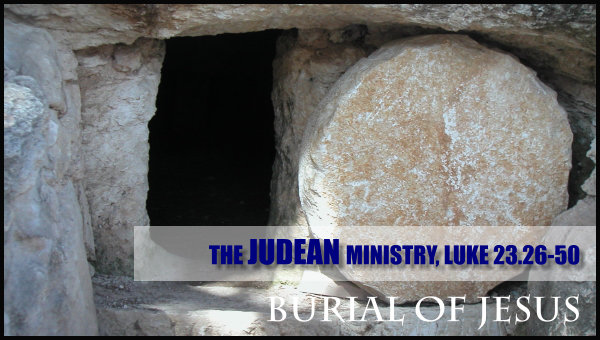By Tyson Thorne

The Judean Ministry at Various Cities (18.1-24.53), 23.50-
Joseph of Arimathea: International Man of Mystery. Some say he was a double agent, both a member of the Sanhedrin council (Luke 23.50) and a disciple of Jesus (Matthew 27.57). He was both wealthy and a man of great faith, something Jesus taught was nearly impossible apart from an act of God. In the 4th century AD the Patriarch of Constantinople, Saint John Chrysostom, was the first to assert that Joseph was one of the 72 apostles commissioned in Luke 10 (which is possible). Later Joseph would be written into legend as the supposed first keeper of the Holy Grail (unlikely).
What Luke tells us is that Joseph was a good and righteous man who, while he might not have directly opposed the Sanhedrin’s plans to kill Jesus, did not give his consent as the other’s did. Mark tells us, however, that the entire council condemned Jesus (Mark 14.64). We can only assume that Joseph was not present at the time of the vote (remind you of any modern congressmen?). We are told he was from Arimathea and identified with Jesus’ message regarding the Kingdom.
Because Jesus was given a Roman execution, Joseph petitioned Pilate for the body of Jesus. This was against tradition, ordinarily a crucified body was taken down and tossed into a valley used as the city’s garbage dump. Crucifixion was meant to erase the person from history, which is at odds with a proper burial. Why Pilate consented is never explained. Perhaps it was because Pilate was never convinced of Jesus’ guilt in the first place. Perhaps the soldiers at the cross testified to Pilate about the events surrounding Jesus’ death. Or maybe he did it simply to irk the Jews.
Either way, with the help of Nicodemus, Joseph took down the body of Jesus, wrapped it carefully in a linen cloth and transported him to his own tomb. Together they prepared his body. They worked quickly as it was the day before the Sabbath, and any work left undone would have to wait until after the Sabbath. Remember, in Jewish custom events started at sunset the day before, so they literally only had a few hours in which to accomplish the task. Thankfully they had help. The same women who had been following Jesus, the one’s who helped finance his ministry, prepared the materials needed for burial and to disguise the odor of death that comes after a few days.
Some believe that the linen Jesus was wrapped in has been recovered and is known today as the Shroud of Turin. There is quite a bit of evidence suggesting this to be the case, though the provenance of the shroud cannot be confirmed. If you’ve been reading Think-Biblically very long you know I don’t hold much regard for holy relics, seeing them as more of a distraction than as evidence. Our faith, while it may be bolstered by archaeology, should never be founded on anything but the Word of God. That said, the Shroud is an interesting artifact. For more information on this see our article here: http://think-biblically.com/8-blog/218-cnn-s-finding-jesus-episode-1
According to Matthew’s account (27.60), Joseph is the one who had a stone rolled in front of the tomb and not the Roman guards as is commonly believed. The stone took several men to roll into place and it fitted neatly into a groove cut in the rocky ground. The groove made it particularly difficult for the stone to ever be moved. This was common practice for tombs of the wealthy and was used to prevent grave robbing. They then retired for the evening and the start of the Sabbath. It would be two days before the tomb was visited again, revealing an astonishing truth.
|
|